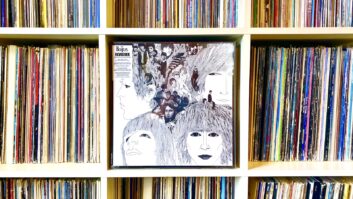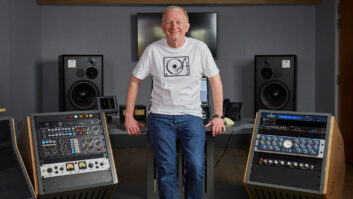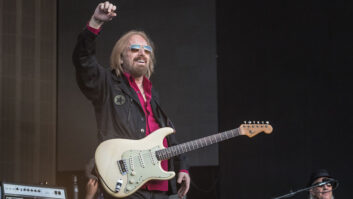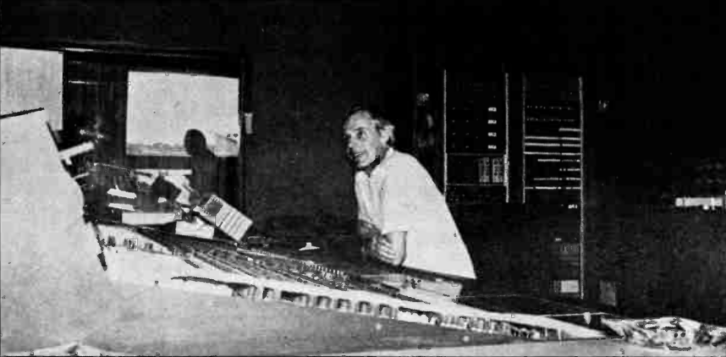
From the January, 1980 issue of Mix, this story, originally titled ‘George Martin: Paradise Found,’ presents an in-depth look at how the legendary Beatles producer launched the luxurious but ill-fated AIR Montserrat destination studio in the Caribbean in 1979. During its decade-long run, the famed facility would go on to host acts like The Rolling Stones, Paul McCartney, Dire Straits, The Police, Jimmy Buffett and others as they created some of their most revered work there. However, when the entire island was ravaged by Hurricane Hugo on September 17, 1989 , the studio became irreparably damaged and was ultimately abandoned.
The idea of the environmental or vacation recording studio can be traced back to the early 1970s with the likes of James Guercio’s Caribou Ranch in Nederland, Colo. And the Record Plant’s twin 24-track, waterside complex in Sausalito, CA.
The concept is simple: It provides a real alternative to big city recording and the more exotic the locale, the more the creative stimulus for the artist. In some instances, the cost of recording is actually less than major recording centers and most of these facilities boast state-of-the-art equipment.
In the past several years, vacation studios have sprouted all over the U.S., as well as internationally, in what can be considered a real trend within the recording studio business. Among successful vacation studios now are Long View Farm, North Brookfield, MA; Le Studio, Morin Heights, Quebec; Bear Creek Recording, Woodinville, WA; Shade Tree, Lake Geneva, WI; Studio In The Country, Bogolusa, LA; and others.
Two newer entries are Indian Creek Recording, a soon-to-be-completed compound on a 4,000-acre ranch in West Texas and Sea-West Hawaii on the beach outside Honolulu.
But perhaps the most spectacular new entry in this field is ex-Beatles producer George Martin’s recently opened AIR Studios Montserrat in the Caribbean.
The 53-year-old Martin, who guided the Beatles through every studio album from 1962 to 1970, had been thinking about a “dream recording studio” ever since the early 1970s. In fact, he admits working at Caribou added impetus to the idea.
“And,” he says, “I was at a point where AIR London had been going for a while and has been so busy and so successful that I couldn’t get into it. And more and more of my work was being done abroad.”
Martin originally joined EMI in London back in 1950 as an A&R man for the Parlophone subsidiary label and eventually became president of that label. He specialized in classical, spoken word and comedy albums, but entered the world of rock n’ roll rather dramatically when he signed the Beatles in 1962. He also went on to produce such artists as Cilla Black, Gerry & the Pacemakers and Billy J. Kramer and the Dakotas.
In 1965, he severed his ties with EMI and with a group of partners formed AIR (Associated Independent Recording) which is now a four, 24-track studio complex in central London with record production, record label, and publishing interests. Four years ago the air/gaits Group of Companies acquired a controlling interest in AIR but the complex, with Martin as chairman, continues its autonomy.
At the beginning, Martin’s “total environment” studio was to be a boat cruising the Mediterranean or Caribbean.
“I thought I would like to have a world mobile studio,” he says, “which would be a superb ship and could go anywhere.” He actually came close to purchasing two ships—one a 160-footer that could accommodate up to 16 people and a smaller boat that would just be large enough for a studio. But economic conditions in England at the time as well as the difficulties a ship underway at sea might present while artists were recording forced Martin to abandon the notion of the boat studio.
He then investigated a land studio in such locales as Canada, Mexico and the Caribbean.
He settled on Montserrat because “It was the first place I’d come to which seemed to be together as a people. The people are warm and friendly, which is not typical in the Caribbean because of the pasts of white people. I also fell in love with the site the studio is now on.”
Montserrat is located in the Eastern Caribbean roughly 900 miles south of Miami or some 250 miles southeast of Puerto Rico. Antigua lies 27 miles to the northeast.
Accessible only by small plane or private boat, the island received its name from Christopher Columbus who felt it reminded him of a mountainous area of Northern Spain.
The 40-square-mile island has a volcanic origin (which accounts for the black sand beaches) and is covered with lush green vegetation. The temperature never drops below 74 degrees Fahrenheit.
The population is nearly 13,000, consisting mainly of native Montserratians. Since the island is a British Crown Colony there is an English-appointed governor. And because of the island’s relative inaccessibility, tourism is not rampant, a fact that does not dis-please the locals. For recording artists it’s an ideal environment.
The AIR Studios Montserrat compound is located on a western portion of the island on a ridge 500 feet up which points down toward the Caribbean Sea.
The 30-acre site consists of a studio and an adjacent villa which contains an open-air dining area, kitchen and spacious lounge. Off the lounge area in a wing are the living quarters for the resident studio manager, chief maintenance engineer and tape operator. There’s also a games room containing a pool table, ping pong table and dart board. A 50-foot swimming pool is just outside.
The lounge, which is accessible to clients, contains a high-end, high-fidelity component system as well as a television and videocassette library on hand.
Clients are not put up at the studio compound but are housed in villas nearby.
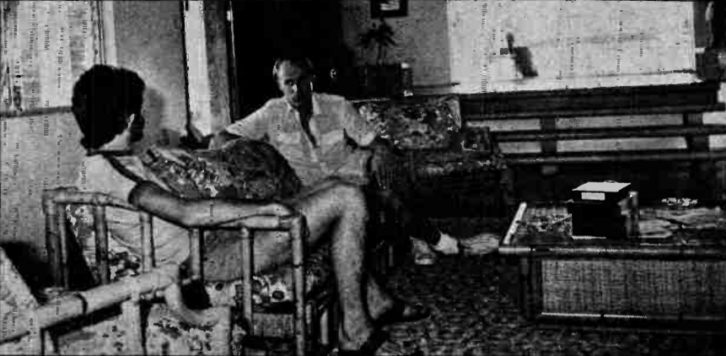
The studio itself measures 30 by 40 feet with the control room 24 feet by 24 feet. There is also a small overdub/vocal room as well as a piano trap. A window in the control room points out to the bay.
The equipment consists of a new generation Neve 52-in/32-out console, two MCI 24-track machines with both auto-locator and lock-up device for 46-track recording, JBL, Tannoy, Altec and Auratone monitors, and a complete array of outboard equipment.
There are also three Ampex ATR 102 stereo two-track machines, two Nakamichi cassette recorders, and two types of EMT reverb (140 and 240 gold foil).
In the outboard array are 24-track Dolby, Neve limiter compressors, UREI graphic and parametric equalizers, digital delay line, phasers and flangers.
Each musician in the studio also has the availability of his own 8-track mixer which enables him to have his own foldback mix regardless of any other performer. The 8-track unit has individual treble and bass controls as well as pan pots and faders.
A Bosendorfer grand piano is situated in the main studio with just the keyboard projecting out and the rest situated in a piano trap for maximum separation.
There are also nearly 50 microphones available including Neumann, Sennheiser, Stancoil, AKG, Shure and Beyer.
“We have quite a bit of outboard equipment,” Martin points out, ‘with a lot of range but it’s silly getting everything. My logic is that every client will want something special. The best alternative is to provide clients with what they want, if they let us know in time. In fact, we encourage clients or their engineers to come first for a quick visit in case they need anything special.”
Martin indicates he likes the Neve board because “It’s practically transformer-less and it’s one of the cleanest consoles I’ve worked with. A criticism in the past with Neve is that the board is a little cloudy at the top end but not with this board.”
The Neve NECAM computer-assisted automation add-on can be interfaced with the console should the studio decide to acquire it later.
“The original concept of the studio,” adds Martin, “was for tracking and not mixing. But I may have to add a smaller mixing room later on. If so, it will have we will book the time for a client and hold it until someone else comes along and wants that same time. We will then go back to the original booker and ask for a deposit. If there’s no deposit, then we will offer it to the second person. That seems to be the simplest way of doing it.”
Martin indicates he would like the studio as well as the groups using it to be efficient. “I’m not sure,” he says, “that three-month bookings are the best. It might not be good for the studio since no one else might want to come if one group had it locked up for so long. It would become their studio. I think most albums, anyway, can be done in three weeks to a month.
“A lot of the big record companies don’t like studios like this because they feel it’s an enticement to spend more money. That’s not true. “The concept makes for peace of mind. I’ve found that groups work faster here than in a city studio. It seems like a paradox. When most people think of an island paradise studio they think that the artist will spend most of his time on the beach and very little time in the studio. But the reverse is true. Clients will spend the morning on the beach or water skiing, for example, but will be in the studio around two and work right through until midnight with one hour off for dinner. People know what they can do here and are efficient.
“In fact, most of the groups who have used the facility to date have underrun and not overrun their booking time. Jimmy Buffet, for example, finished a week ahead of schedule. Some record companies feel studio owners want to keep their groups in for as long as possible to make money but that’s not the case. Studio owners like efficiency as well.”
Martin further adds that he now intends to devote more time to AIR Studios Montserrat but will keep active as a producer.
He says he wants to produce a wide variety of things, everything from rock ‘n’ roll to classical work. He also wants to spend more time working on film scores and writing music and songs for films. After the Beatles, Martin, who still makes his home in England, began producing the group America and recently produced the group’s Silent Letter LP for Capitol.
He spent 18 months in America during the 1977/1978 period producing the music for the Sgt. Pepper’s Lonely Hearts Club Band movie. Another recent rock project was a solo Gary Booker LP for Chrysalis. Brooker used to be the lead singer of Procol Harum.
‘The next five years,” he says, “will be devoted to AIR Montserrat. And I will continue to do what I think I can do best. I also want to do more film music.” Martin will score and write music for the upcoming film Honky Tonk Freeway.
Towards the future also, Martin is eyeing developments in digital recording technology.
“I am purposely holding off on digital right now,” he says, “because of the mess it’s in. There is no standardization. I think it’s in danger of becoming like 4-channel, but I will hop in there once digital is here and hope to have it not only at AIR Studios London but also in Montserrat.
A Los Angeles studio in partnership with Chrysalis has also been examined but again, according to Martin, a move now before “digital is sorted out” would be premature.
